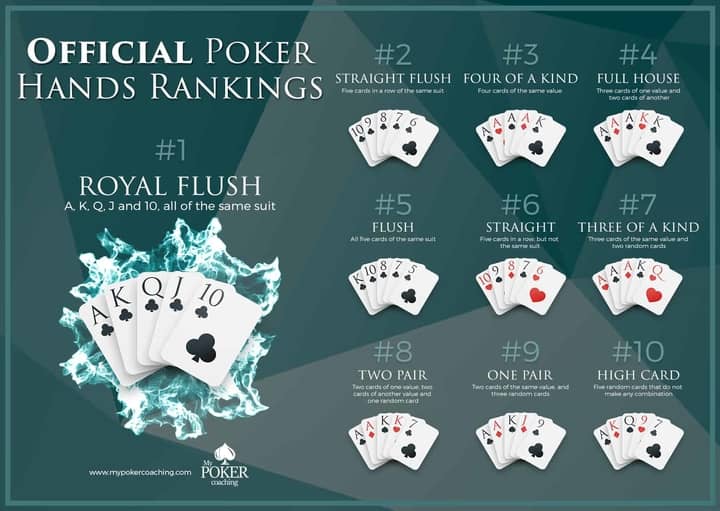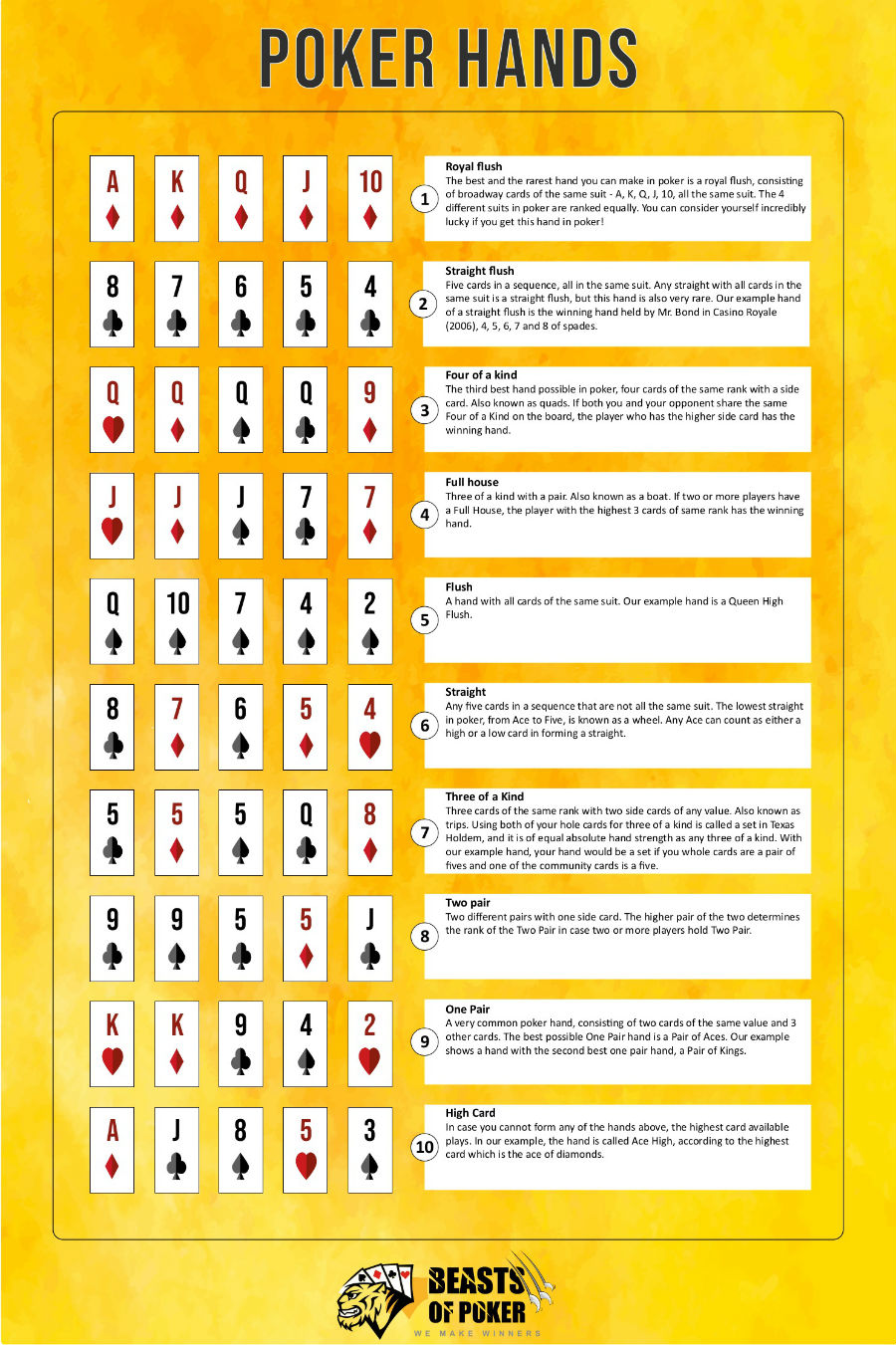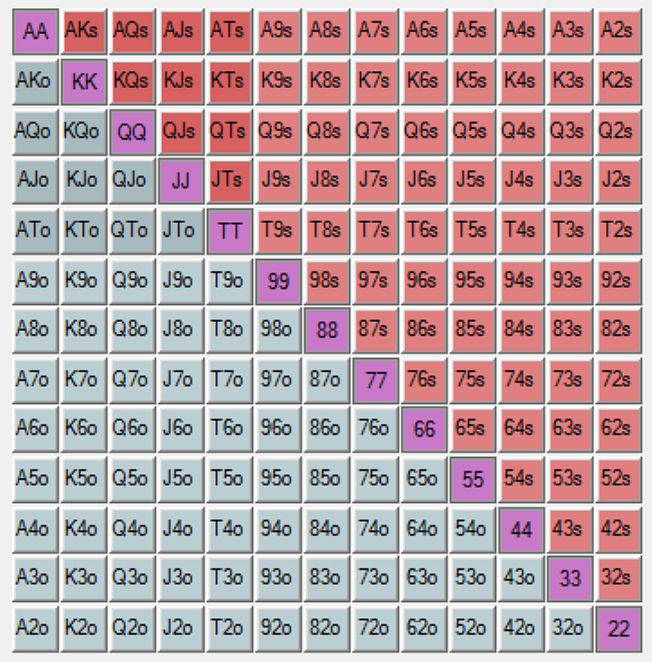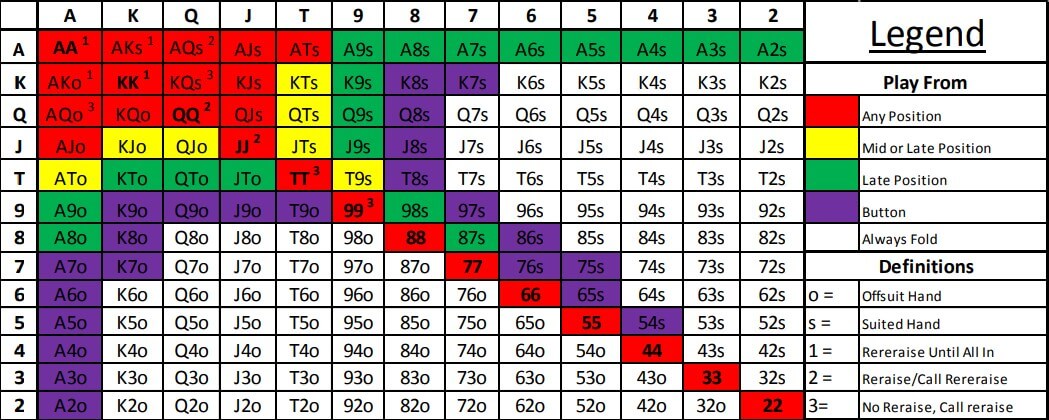All Winning Hands In Texas Holdem
The Royal Flush, as the name suggests, is the best possible hand in Texas Holdem. This hand combination is made up of the five highest cards in a deck – the Ace, King, Queen, Jack and the number 10. The royal flush must have all these characters of the same suit. High card is the lowest possible poker hand in Texas Hold’em, Made of any 5 cards. For example, A-Q-6-5-10. For example, A-Q-6-5-10. Download our Poker Hand Rankings Chart in PDF format for a quick and easy way to reference how your hand stacks up. Proper hand selection in Texas Holdem can help you avoid many costly mistakes on later streets, so learning to adjust your opening ranges based on your position and opponents is very important. The best way to quickly learn it is to grab a poker cheat sheet with all.

NL Hold’em Starting Hand Charts
One aspect of the game of No-Limit Hold’em that causes beginning players much grief is deciding which hands to play and which hands to dump. NL Hold’em is much more difficult than Limit Hold’em because the value of a hand depends on so many factors other than just the cards in your hand. Despite this difficulty, our coaches believe that following some general guidelines and adjusting from these is a better solution than having no guidelines at all. Given that well over half of your profitability in NL Hold’em is based on hand selection alone, we have developed these charts to help you better determine whether to play or fold.
There are no perfect No-Limit starting hand charts. That is because there are many factors that affect your decision, and charts cannot account for all of them. Some of these include:
- The size of your opponent's stacks.
- How loose or tight, passive or aggressive, your opponents are.
- Where these opponents are located at the table – for example, does an aggressive player still have to act after you?
- Your image at the table – for example, how tight or tricky you are perceived.
That being said, these charts will serve you well in most typical low-stakes No-Limit cash games, such as games with blinds of $1/$2, and home games. These games typically have several loose players at the table, and good opportunities for winning big pots with suited connectors and pocket pairs. With practice, you will be able to be a consistently winning player with these charts as a starting point. As you improve, you'll find yourself making adjustments to these charts based on the factors listed above, and more.
AGAIN: These charts are a good starting point for beginners. Specifically, Chart #1 recommends a significant amount of limping. This is great in loose, passive games but less often seen in tougher games. You’ll find other training material on Advanced Poker Training that may recommend a more aggressive approach for more experienced players.
Note: It would be a serious mistake to apply these hand charts before reading the Frequent Asked Questions first.
CHART #1 ‐ LOOSE, PASSIVE GAME (OFTEN 4-5 LIMPERS PER HAND)
NO ONE HAS RAISED YET
- Raise Always
- Call from Early Position, otherwise raise
- Call always
- Call from Middle or Late Position if the conditions are right (see Frequently Asked Questions)
CHART #2 ‐ TIGHTER GAME (FEWER LIMPERS) OR MORE AGGRESSIVE GAME
NO ONE HAS RAISED YET
- Raise Always
- Call from Early Position, otherwise raise
- Call (or Raise) from Middle or Late Position if the conditions are right (see Frequently Asked Questions)
CHART #3 ‐ THERE HAS BEEN A SINGLE RAISE
(3‐5 TIMES THE BIG BLIND) BEFORE YOU

- Re‐Raise Always
- Call from Early Position, otherwise re‐raise
- Call always
- Call from Middle or Late Position if the conditions are right (see Frequently Asked Questions)
FREQUENTLY ASKED QUESTIONS
For the hands in yellow, what do you mean when you say to play these hands if the conditions are right? The hands in yellow are speculative hands. They should always be folded from Early Position. From other positions, they can be profitable given the right conditions. Some of the questions to ask yourself:

- Are there other players who have called so far (the more, the better)?
- Are the players who have called playing poorly after the flop? Will they pay me off if I hit something?
- Is there an aggressive player still to act behind me (you might get raised and have to fold)?
- If there has been a raise and no other callers, what chance do I have of using my position after the flop to win the hand even if I don't improve (Chart #3 only)?
Why does Chart #2 say to sometimes raise with the hands in yellow, but Chart #1 does not? We have different goals in mind. Using Chart #1, we want to call to encourage additional players to enter the pot. These hands will be immensely profitable when our loose, passive opponents enter the hand, and get trapped when we flop a set, or make a well-disguised straight. When using Chart #2, however, we want to size up the opponents still to act. If they are tight, we can raise. Sometimes, we'll pick up the blinds. Other times, our pre-flop aggression will allow us to take down the pot on the flop.
What's the difference between AKs and AKo? AKs means an Ace and King of the same suit. AKo means an Ace and King of different suits.
What are early, middle, and late position? Early Position is generally the first 2 (in a nine player game) or 3 (in a ten player game) positions after the blinds. Late Position is the “cutoff” position (to the right of the dealer), and dealer button positions. Middle Position is everything in between.
How much should I raise? As a general rule, raise 3 to 4 times the big blind, plus 1 extra big blind for every player who has called before you. So if there are 2 callers already, raise between 5 and 6 times the big blind.
What if someone raises after I call? Whether you call the raise depends on how much money the raiser has for you to win, how many other players are involved, and what type of hand you have. As a general rule, if you have a pocket pair, lean towards calling. If there are a lot of other players (and therefore a big pot), lean towards calling. In general, fold suited connectors from early position. Fold hands like KQ that don't play well against a raiser.

How do I play from the blinds? From the small blind, play the same hands you would play from late position, plus a few more. But don't call with junk hands like T5o, just because it is “cheap”. From the big blind, if there is a raise to you, play like you would if you had already called from early position.
The chart says to fold KQo to a raise. Really? Yes, this hand performs very poorly against typical raising hands. Against AK, AQ, AA, KK, QQ, you are a big underdog. Other typical raising hands like JJ, TT, 99, AJs, are slightly ahead of you as well. The only time you might call or re-raise is from late position, if the opener was in middle or late position, indicating they might have a wider range of hands.
I was told to fold AJo from Early Position, why do you say to call with it? Folding AJo is not a bad idea in many games. We included it because, at low stakes tables (even tight or aggressive ones), the players are often playing badly enough after the flop that it can be profitable. We used data from millions of hands of low-limit poker to analyze this. The same could be said for KQo, ATs, and KJs – you can make a small profit in the long run at most low-stakes games, but folding would be perfectly acceptable from early position.
Can I use these charts in a NL Hold'em tournament? The charts would be best applicable to the early stages of a NL tournament, when everyone has a deep stack. In the middle and later stages, they should not be used.
Read all our instructional articles
How to Determine the Winning Hand in Texas Hold’em
The first thing players brand new to poker have to learn is how to read the board or five “community cards” in order to determine the winning hand in Texas hold’em. The most important thing to remember is that when making your hand you use the best five cards available among the seven total cards — that is, your two hole cards plus the five cards on the board.
In hold’em you can use any five cards out of the seven to make your hand — in fact, you don’t even have to use the two hole cards which were dealt to you! This is called “playing the board,” and it happens if your best five-card poker hand is the one which is on the board in front of you.
For example, if you get dealt pocket aces and the board is , your best hand is the nine-high straight on the board in front of you — in other words, your aces don’t even play. In this case, you will chop the pot with your opponent when it comes to showdown unless of course the other player has or and makes a better straight.
Kicker problems
Another thing to bear in mind is that even with your one-pair hands — where most new players attention only to the pair they have — you need to be aware of the value of your total five-card hand.
For example, say you have and the board reads . That means your best five-card hand is A-A-10-7-5 — that is, the pair of aces plus the three highest other cards available, the ten, the seven, and the five. In this hand if you put your opponent on a pair of aces as well, the likelihood your would be best is in fact very slim given that the only other hand you beat would be . That’s because on this board your non-ace card or “kicker” plays.
It is always favorable to have a high card as your kicker when you make a pair, as having a high kicker helps improve the value of your full five-card hand. In the above example, a player holding on that board would have a pair of aces with a queen kicker (A-A-Q-10-7) — a relatively strong hand with which the player could be more confident than with ace-five.
Two-pair hands
One of the most common areas of confusion for new players when it comes to determining who has the winning hand is when both players have two-pair hands.
On a board which reads , let’s say one player turns over while another shows . I’ve seen new players in this situation who have the sixes mistakenly think their two-pair hand must be best, simply by virtue of the fact that they hold a pocket pair. But they’re wrong.
Let’s go through the five-card analysis again. The best five-card hand for the player with is sixes and fours with a ten — 6-6-4-4-10. Meanwhile the player holding has tens and fours with a nine — 10-10-4-4-9 — or a higher two-pair hand. This can be very tilting for the player with the pocket pair.
Counterfeiting
Finally, let’s have a look at something called counterfeiting. This doesn’t happen too often, but when it does you need to be aware of it.
Counterfeiting occurs when a community card is dealt that both alters the value of your own hand and increases the chance of an opponent having a better hand than you. It’s a little odd, because what happens is that your hand technically improves while likely making it less strong relative to your opponent’s hand.
For example, on a board of a player who has has a two-pair hand and is ahead of an opponent holding . But if a were to fall on either the turn or river, the player holding pocket aces would improve to a better two-pair hand (aces and jacks) and gain the advantage.
Texas Holdem Hand Percentage Chart
Notice how the player with would also improve to a better hand if a jack comes (going from sevens and fives to jacks and sevens) — but unfortunately the card that improved the hand also made it worse than the other player’s hand. Using the terminology of the game, the player’s two-pair hand has been “counterfeited” as the pair on the board gave the other player a better two-pair hand.
Average Winning Hand In Texas Holdem

As in all of these examples, it is very important always to keep track of your best five-card hand. When you’ve done it for long enough, it may even start to seem like second nature recognizing what hands beat what. However, there may still be occasions when you end up staring at the board for a good minute trying to figure out what you have (and at the same time what your opponent might have!) and if you have the winning hand in your Texas hold'em game.
Winning Hands In Texas Holdem Poker
Want to stay atop all the latest in the poker world? If so, make sure to get PokerNews updates on your social media outlets. Follow us on Twitter and find us on both Facebook and Google+!
All Winning Hands In Texas Holdem Old Em Poker
Tags
cash game strategytournament strategybeginner strategyhand readingruleshand rankingsno-limit hold’em